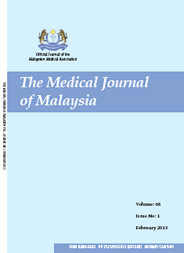MJM, Vol 70 Supplement 1 September 2015
Food intake among
Malaysian adults: are we meeting individualised recommendations?
*Institute for Public Health, Ministry of Health Malaysia, **Program of Nutrition, School of Health Sciences, Universiti Sains Malaysia
ABSTRACT
Introduction: The Malaysian Food Pyramid is a simple guide for individuals to vary their food intake according to total daily food serving recommendations. This paper aimed to evaluate the extent to which Malaysian adults meet this recommendation.
Methods: Malaysian Adults Nutrition Survey (MANS) was a cross-sectional study conducted from March to June 2014. A nationwide total of 3,000 adults aged 18 to 59 years old were interviewed using a semi-quantitative food frequency questionnaire (FFQ) which consisted of 165 food items. At analysis, the food item was grouped into 7 categories and compared to their recommendation as in Malaysian Food Pyramid.
Results: As many as 66.8% of Malaysian adults met the recommended serving per day for ‘meat, poultry and egg’ followed by 41.3% for ‘cereal and cereal product’, 31.3% for ‘fish and fish product’, 24.4% for ‘milk and dairy product’, 17.1% for ‘legumes and nut’, 14.9% for ‘fruits’ and finally 7.9% for ‘vegetables’. This study found ‘Legumes and nut’ (81.9%) to be the top food group consumed below the recommended serving per day followed by ‘vegetables’ (81.1%) and ‘milk and dairy products’ (73.6%). On the other hand, ‘fish’ (38.6%), ‘fuits’ (26.0%) and ‘meat, poultry and egg’ (13.1%) were the top three food groups consumed over the recommended serving per day. Generally, urban adults managed to meet recommended servings better than the rural population especially for ‘legumes and nut’, χ2(1) = 8.070, p<0.05.
Conclusion: Over 50% of Malaysian adults failed to meet the recommended serving size for all food groups with the exception of ‘meat, poultry and egg’ group. Furthermore, less than 25% of Malaysian adults met the recommended intake for ‘vegetables’, ‘fruits, ‘legumes and nut’ and ‘milk and dairy product’. Therefore, tremendous action must be taken holistically to increase the awareness of the Malaysian population to practice healthy eating in their daily living.
Keywords: food serving intake, food frequency questionnaire, adults, recommendation, Malaysian Food Pyramid
